

Komal Singh: Recoding stories: the power of inclusive books at scale. Youtube. EJ994981. Wendy Knight Agard: From the Inside Out: Diversity, Inclusion & Belonging. Missing Adventures: Diversity and Children's Literature. #FlipgridForAll: Accessibility and Inclusion for Every Voice — Flipgrid. Hi!
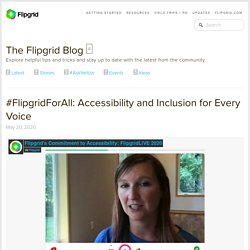
👋 I’m Liz, and I lead accessibility here at Flipgrid. Our mission is to empower every learner on the planet to share their voice and respect the diverse voices of others. At the core of that mission is to make Flipgrid the most inclusive and accessible platform possible! Since last year’s FlipgridLIVE, we have made nearly 1,000 accessibility improvements and counting. I can’t wait to see where we’ll be at for FlipgridLIVE 2020! What's the Big Idea? Integrating Young Adult Literature in the Middle School. By: Marshall A.
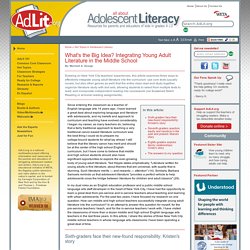
George Drawing on New York City teachers' experiences, this article examines three ways to effectively integrate young adult literature into the curriculum: use core texts (usually novels, but also other genres as well) that the entire class read and study together; organize literature study with text sets, allowing students to select from multiple texts to read; and incorporate independent reading into coursework (via Sustained Silent Reading or at-home reading assignments). Since entering the classroom as a teacher of English language arts 14 years ago, I have learned a great deal about exploring language and literature with adolescents, and my beliefs and approach to curriculum and teaching have evolved considerably. I began my career, as many teachers do, believing that a fairly traditional approach to teaching a very traditional canon-based literature curriculum was the best thing I could do to prepare my college-bound students for what lay ahead.
Marshall A. Equity and Inclusion in Children's and Young Adult Books: Overview - Cynthia Leitich Smith. The conversation around diversity and inclusion has been buzzing since Nancy Larrick’s article, “The All-White World of Children’s Books,” was published on Sept. 11, 1965 in The Saturday Review.
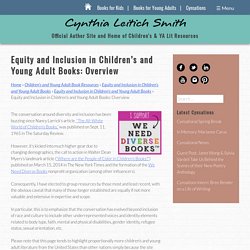
However, it’s kicked into much higher gear due to changing demographics, the call to action in Walter Dean Myers’s landmark article (“Where are the People of Color in Children’s Books?”) Published on March 15, 2014 in The New York Times and the formation of the We Need Diverse Books nonprofit organization (among other influencers). Consequently, I have elected to group resources by those most and least recent, with the obvious caveat that many of those longer established are equally if not more valuable and extensive in expertise and scope. Please note that this page tends to highlight proportionally more children’s and young adult literature from the United States than other nations simply because the site authors are most well acquainted with that category. Mirrors? Youtube. How Educators Can Talk About Inclusive Language With Young People.
EJ963437 - Inclusive Literature in the Library and the Classroom: The Importance of Young Adult and Children's Books that Portray Characters with Disabilities, Knowledge Quest, 2011. Literature for children and young adults is written for many different reasons.

It is written purely to entertain, to help children and young adults understand the world they live in, or to help cope with problems they face. It can also be written to introduce new places, ideas, or situations to its readers, or to portray characters with whom readers can relate to better understand themselves. Children's and young adult books that portray characters with disabilities are important tools for helping all readers learn about, understand, and relate to people with disabilities. Readingrockets. Throughout the year, literacy events and celebrations can be a great way to get kids excited about books.
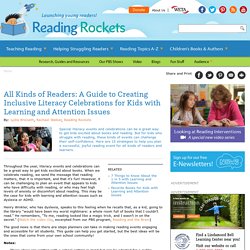
When we celebrate reading, we send the message that reading matters, that it is important, and that it’s fun! However, it can be challenging to plan an event that appeals to kids who have difficulty with reading, or who may feel high levels of anxiety or discomfort about reading. This may be the case for kids with learning and attention issues such as dyslexia or ADHD. Henry Winkler, who has dyslexia, speaks to this feeling when he recalls that, as a kid, going to the library “would have been my worst nightmare: a whole room full of books that I couldn’t read.”
He remembers, “To me, reading looked like a magic trick, and I wasn’t in on the secret.” Diverse and Inclusive Books to Inspire Young Adults. By the time readers are young adults, their worlds have broadened to include a wide range of people and life experiences that inform their developing identities. As teenage readers discover who they are, it's important that they have access to stories that reflect and celebrate the full range of human experiences and a diversity of race, ethnicity, sexual orientation, gender identity, physical and mental abilities, religion, and culture. The following topics and themes are explored in this list: For even more Scholastic books that explore these themes, check out our catalog, The Power of Story: Diverse Books for All Readers. Inclusive Literature in the Library and the Classroom. Culturally Sustaining and Inclusive YA Literature: Valuing the Knowledge, Stories, and Truths of Adolescent Life.
This post was written by NCTE member R.
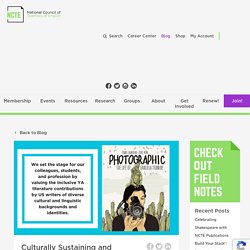
Joseph Rodríguez. Across the country, young adult (YA) literature is a growing field in publication, research, and teaching, and includes youth and adolescent studies, literary criticism, and literacy education. In the search for a balance between the classics and contemporary classics, educators and scholars seek literary works that speak to the lives of adolescents ages 12–20.